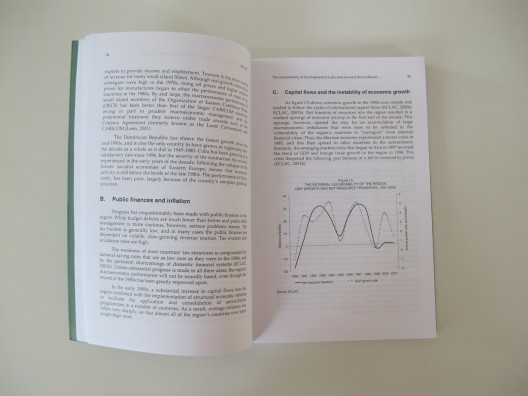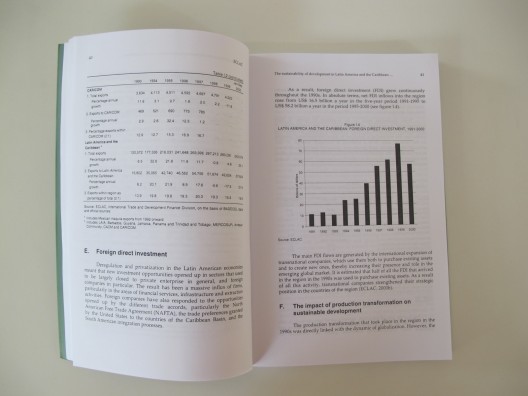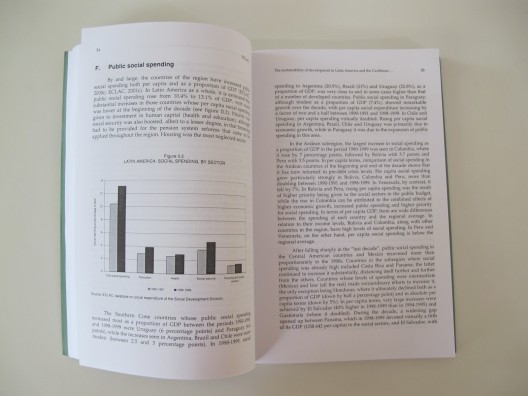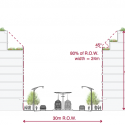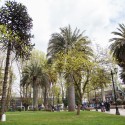The sustainability of development in Latin America and the Caribbean: challenges and opportunities
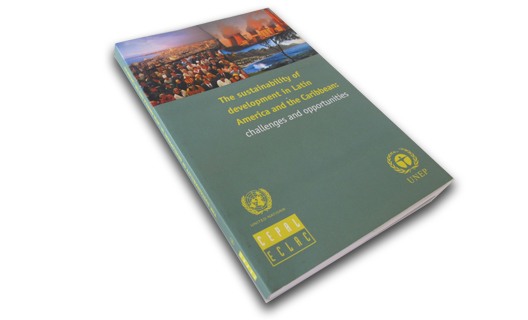
The sustainability of development in Latin America and the Caribbean: challenges and opportunities
Autor: Roberto Guimarães, Julia Carabias Lillo, Guillermo Acuña, Fernando Tudela Abad, Enrique Provencio y José Luis Samaniego Leyva.
Idioma: inglés
ISBN: 92-1-121357-6
Año: 2002
Dónde conseguirlo: puedes descargarlo en español y en inglés.
Sobre el libro:
La siguiente publicación fue una referencia para la Conferencia Regional de América Latina y el Caribe, instancia preparatoria para la Cumbre Mundial sobre Desarrollo Sostenible que se desarrolló en Rio de Janeiro en octubre de 2001.
El trabajo se divide en tres grandes apartados, en el primero se presenta un balance del desempeño económico regional. Se describen las principales tendencias del desarrollo social en los años noventa, analizando temas como la evolución del empleo regional, la distribución del ingreso, los desafíos que enfrenta la sostenibilidad del desarrollo, entre otros. Además se revisa la situación ambiental de la región con temáticas como los ecosistemas naturales, los recursos hídricos y los fenómenos de contaminación.
La segunda parte del libro, es un análisis más propositivo, en el que se propone la labor que podría jugar la región en el escenario global. Por último, se presentan iniciativas que apuntan al desarrollo sostenible de la región, considerando las ventajas comparativas de ésta y los desafíos que se viene en el futuro.
Índice:
Foreword
Summary
Introduction
Part one Sustainability in the region
Chapter I
Economic performance in the 1990s
A. Economic growth in Latin America and the Caribbean
B. Public finances and inflation
C. Capital flows and the instability of economic growth
D. Economic openness, trade and integration
E. Foreign direct investment
F. The impact of production transformation on sustainable development
Chapter II
Major trends in social development in the 1990s
A. Employment
B. Loss of job security
C. Inequality in income distribution
D. Inequalities in land distribution
E. Relative decline in poverty
F. Public social spending
G. Social challenges for sustainability
Chapter III
Demographic trends
A. Population and environmentally sustainable development
1. Demographic transition as a challenge for governments and societies
2. The dependency ratio and the demographic bonus
3. The population/resources ratio. Carrying capacity
4. Mobility of regional population: migrations
5. Migration and remittances
6. Spatial trends in population settlement
Chapter IV
The environmental situation in the region
A. Natural ecosystems
1. Natural land ecosystems
2. Marine and coastal ecosystems
B. Water resources
1. Water resources and their availability in the region
2. Water management in the region
C. Urbanization and the environment
D. Pollution
1. Air
2. Drinking water and sanitation
3. Waste
4. Changes in industrial pollution
5. Rural and diffused pollution
E. Energy trends in the region and global climate change
1. Energy trends in Latin America and the Caribbean over recent decades
2. Latin America and the Caribbean and global climate change
3. The contribution of Latin America and the Caribbean to total emissions
Chapter V
Socio-environmental vulnerability
A. The world context
B. Natural disasters in the region
C. The socio-economic impact of disasters in the region
Chapter VI
Public policies
A. The institutional framework for the environment
B. Evolution of regulatory frameworks
C. Integration of public policies
D. Experiments with the use of economic instruments in environmental management
E. Participation for sustainable development: sustainable development at the national and local levels; participation of leading actors from civil society and the productive sectors
1. Sustainable development at the national and local levels
2. Civil society and citizen participation
3. Participation of the business sector in sustainable development
Chapter VII
International framework
A. Pre- and post-Rio multilateral environmental accords
B. The region and global environmental problems
C. The Latin American and Caribbean response
D. Subregional integration and sustainable development agendas
E. Imperatives for a new institutional structure
Part two Future prospects
Chapter VIII
The region’s role in a global alliance
A. Recognizing the progress made
B. A disturbing assessment
C. The main challenges
D. Constraints in national and global agendas
E. The uniqueness of the region
F. Domesticating globalization for sustainable development
G. Synergy between agreements and more efficient environmental institutions
H. Convergence between global agreements and the regiI. Knowledge and technology for sustainable development
J. Towards a new stage of policy integration
K. Public participation
Chapter IX
Proposals for future action
A. Protection and sustainable use of natural ecosystems and biodiversity, and access to genetic resources
1. Protection and sustainable use of natural ecosystems and biodiversity
2. Access to genetic and transgenic resources
3. Regional and global alliances
B. Vulnerability
1. Natural disasters
2. Vulnerability and sustainable development in small island States
C. Water management
D. Energy management
1. Climate change
2. Energy efficiency
E. Urban management
F. The institutional underpinnings of sustainable development
Bibliography
Annex – Rio de Janeiro Platform of Action on the road to Johannesburg 2002
Extracto: “En los años noventa, los países de América Latina y el Caribe atravesaron una etapa de transformación caracterizada por profundas reformas económicas centradas en una mayor apertura comercial, así como en la liberalización de los mercados financieros nacionales y de los flujos de capitales con el exterior, y acompañadas de un papel preponderante de la iniciativa privada en la producción de bienes y servicios y en la provisión de servicios públicos y prestaciones sociales. A partir de 1990, la actividad productiva empezó a recuperarse y muchas de las presiones inflacionarias y desestabilizadoras se fueron abatiendo gradualmente, dejando atrás la llamada década perdida en el desarrollo económico de la región. No obstante, los ritmos de crecimiento económico del conjunto de la región siguieron siendo significativamente inferiores a los alcanzados en las décadas anteriores a la crisis de la deuda.”

